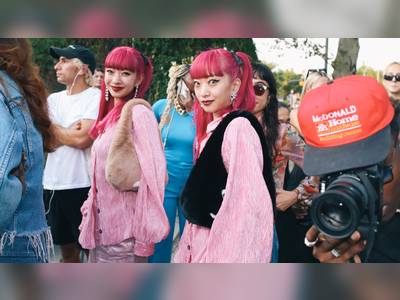But make no mistake - burlap sacks these are not. Ackerman, 22, has created Flight, a line of soft and cosy knitwear using materials such as organic cotton, recycled polyester and bamboo.
Her collection will debut with five pieces at Mass Exodus, Ryerson's annual fashion show, on April 8 and 9, then it will be on display again April 10 at Toronto Alternative Fashion Week, where she will show a 10-piece collection.
Q: What is your collection all about?
A: I began with sustainability - using organic materials, making choices about responsible materials and work. I've always been really interested and passionate about knitwear, so I decided to do a collection of pretty much all knitwear and have gotten all these pieces hand knit with different prints in them.
Q: Why did you choose to create an environmentally friendly clothing line?
A: I'm very passionate about the planet. I love the Earth, of course, it's how we live. Being a designer we have the responsibility and choices, I think, to create change. Maybe if I wasn't a designer it wouldn't be as pertinent and I would just do it in my own life, but I feel like as a designer you can really effect a lot of change and affect a lot of people, because everybody wears clothes. Feeling like I have that responsibility has really inspired me to try to keep on this path.
Q: What was your inspiration?
A: It was originally inspired by my nephew, who is obsessed with birds and does all these amazing drawings of birds. So I decided to take those and translate them into textiles and prints. Each piece is knitted with a different bird in it, it's either graphic or really abstracted. I wanted to show that sustainability can be innovative and stylish and colourful. It doesn't have to be bland or like burlap sacks. It can be a really great choice for designers and consumers alike.
Q: What materials did you use?
A: There's recycled polyester and organic cotton. There's lots of organic cottons and hemp and silk and bamboo, which is a really amazing fibre that doesn't use any pesticides or herbicides to grow it and it grows really, really quickly so it can have a lot of turnover. It's super soft and it gives nutrients back to the soil, so it's actually really one of the most sustainable materials.
Q: So as with everything else, it just takes a bit more effort in fashion to be eco-friendly?
A: That's something I'd like to work on, is to try to make it so it's more accessible for designers and consumers alike. Most people when faced with the organic choice or the normal choice will go with the cheaper one, which right now is the non-organic.
Q: What does it take to be eco-friendly in fashion?
A: There's so much to think about , it's unbelievable: where is it made, where have your fabrics come from, do they fly across the ocean to come to you - that's a huge carbon footprint, when you're putting on a show, how is it powered, how much paper did you use? You could scrutinize everything.
Q: What's involved in creating a line from scratch?
A: It's been a really long year. I'm pretty sure none of us have slept properly for seven months. It's a really big investment in time and money, but we all really love what we're doing and are really passionate about it, so it seems OK.
Q: You suggest consumers looking to buy sustainable clothing should seek out local designers. Is it harder for big companies to be sustainable?
A: They're more likely to do it for a short period of time, while this trend is around, then maybe stop. But it would be really great if large companies did change over, because that would make such a huge ripple in the whole industry and I think that's what really needs to happen. As small, local designers it's harder for us. If we do make a change it's only a small ripple, whereas large corporations transferring to organic cotton or more sustainable methods of production would make a huge effect around the world.
Q: Do you think bigger companies will push through the green trend and continue to produce eco-friendly clothing?
A: I think the way that big companies are going to make the change is realizing that it makes good business sense. You can save a lot of money by going green and turning to different ways of using energy or being more efficient with your use of resources.













